After ‘Yolanda,’ gossip is good

AN IMAGE of the Virgin Mary sits among the rubble after a storm surge washed away homes and structures in Tacloban City on Nov. 8 last year. RICHARD BALONGLONG/INQUIRER NORTHERN LUZON
TACLOBAN CITY—It has been a common site in Barangay 89 in San Jose District—women huddled to gossip.
The onslaught of Supertyphoon “Yolanda” on Nov. 8 last year altered the village landscape though women still huddle in whatever is left of their communities only, this time, not to gossip but to talk about the tragedy.
There’s so much to talk about. The destruction that Yolanda brought to their communities is unprecedented. Walls of water as high as 6 meters slammed into houses made of light materials, easily crushing them like paper waste.
Among the worst hit was Barangay 89, a fishing village that lost at least 200 of its people to Yolanda.
Four months after the tragedy, the village women slowly returned to their old routine of sharing stories, but it is now about what they went through at the height of Yolanda.
Article continues after this advertisementTalking has helped the women of Barangay 89 cope with the tragedy.
Article continues after this advertisement“Talking about our experiences during the supertyphoon gave us some relief. After our sessions, we ended up feeling light,” said Merlita Marga, 45.
Some of the women would cry, but it’s OK.
Coping mechanism
An official of United Nations Population Fund (UNFPA) encouraged the women to do just that—talk. It is a good coping mechanism, the official said.
“It’s really important for our women to undergo stress debriefing,” said Sandra Gani of UNFPA.
“Just imagine what will happen to our society if our women will break down. Of course, this will take some time. It is not a one-shot deal. It takes some time before we can process their emotions,” Gani said.
UNFPA has been conducting a series of stress debriefing sessions with women in Leyte province to help them cope with the tragedy.
Marga said that before Yolanda, women would form small groups in the village to talk about their neighbors.
“We would not notice the time passing by when we talked about the latest gossip in the barangay. Sometimes, we would even forget to do our household chores because we were so busy with gossiping,” said Marga, a mother of 10 children.
Her friend, Gloria Agojero, 44, and a mother of six, agreed with Marga, saying the women would hold sessions by the road in the village in front of the historic Leyte Gulf, the site of one of the world’s greatest naval battles during World War II.
Change of topic
After Yolanda, their gossip session took a drastic change.
“Unlike before, what we are discussing now are our experiences during the typhoon and how we survived, and not merely to gossip around,” said Rowena Ponferrada, 48, who has eight children.
The sessions, she added, brought the women in the village closer.
Rodora Postanes, 35, said the sessions now were worth their time.
“Talking among ourselves gives us a sense of relief. It feels good,” said Postanes who has three children.
The four women said the sessions were their own form of stress debriefing.
“Whenever there is a group of women, chances are they are discussing about their Yolanda experiences,” Marga said.
The four women—Postanes, Marga, Ponferrada and Agojero—were lucky that they didn’t lose any family member during Yolanda.
They and their children joined their neighbors at San Jose Elementary School, where they fled to a day before Yolanda struck. The school was hit by a storm surge.
“The water reached the roof of the room where we were all in. We just hung on to the trusses to survive. We were all crying, thinking that we would die,” Marga said.
Her husband, Nilo, chose to stay in their house that was destroyed by the storm surge. The 43-year-old man was swept by the rampaging waters but was able to hang on to a tree in Barangay Manlurip, about
2 kilometers fom Barangay 89.
They said that four months after Yolanda, they could now manage to laugh. Still, they said, the horror of Nov. 8, 2013, was something they would never forget.